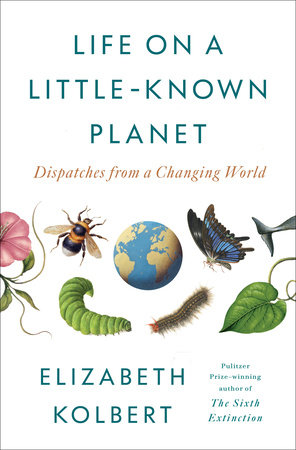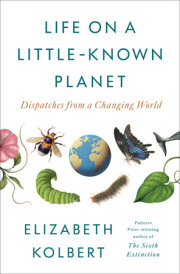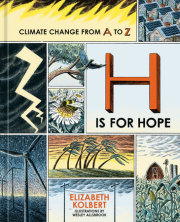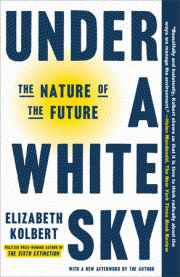Talk to MeCan Artificial Intelligence Allow Us to Speak to Other Species?David Gruber began his almost impossibly varied career studying bluestriped grunt fish off the coast of Belize. He was an undergraduate, and his job was to track the fish at night. He navigated by the stars and slept in a tent on the beach. “It was a dream,” he recalled. “I didn’t know what I was doing, but I was performing what I thought a marine biologist would do.”
Gruber went on to work in Guyana, mapping forest plots, and in Florida, calculating how much water it would take to restore the Everglades. He wrote a PhD thesis on carbon cycling in the oceans and became a professor of biology at the City University of New York. Along the way, he got interested in green fluorescent proteins, which are naturally synthesized by jellyfish but, with a little gene editing, can be produced by almost any living thing, including humans. While working in the Solomon Islands, northeast of Australia, Gruber discovered dozens of species of fluorescent fish, including a fluorescent shark, which opened up new questions. What would a fluorescent shark look like to another fluorescent shark? Gruber enlisted researchers in optics to help him construct a special “shark’s eye” camera. (Sharks see only in blue and green; fluorescence, it turns out, shows up to them as greater contrast.) Meanwhile, he was also studying creatures known as comb jellies at the Mystic Aquarium, in Connecticut, trying to determine how, exactly, they manufacture the molecules that make them glow. This led him to wonder about the way that jellyfish experience the world. Gruber enlisted another set of collaborators to develop robots that could handle jellyfish with jellyfish-like delicacy.
“I wanted to know: Is there a way where robots and people can be brought together that builds empathy?” he told me.
In 2017, Gruber received a fellowship to spend a year at the Radcliffe Institute for Advanced Study, in Cambridge, Massachusetts. While there, he came across a book by a free diver who had taken a plunge with some sperm whales. This piqued Gruber’s curiosity, so he started reading up on the animals.
The world’s largest predators, sperm whales spend most of their lives hunting. To find their prey—generally squid—in the darkness of the depths, they rely on echolocation. By means of a specialized organ in their heads, they generate streams of clicks that bounce off any solid (or semisolid) object. Sperm whales also produce quick bursts of clicks, known as codas, which they exchange with one another. The exchanges seem to have the structure of conversation.
One day, Gruber was sitting in his office at the Radcliffe Institute, listening to a tape of sperm whales chatting, when another fellow at the institute, Shafi Goldwasser, happened by. Goldwasser, a Turing Award–winning computer scientist, was intrigued. At the time, she was organizing a seminar on machine learning, which was advancing in ways that would eventually lead to ChatGPT. Perhaps, Goldwasser mused, machine learning could be used to discover the meaning of the whales’ exchanges.
“It was not exactly a joke, but almost like a pipe dream,” Goldwasser recollected. “But David really got into it.”
Gruber and Goldwasser took the idea of decoding the codas to a third Radcliffe fellow, Michael Bronstein. Bronstein, also a computer scientist, is now the DeepMind Professor of AI at Oxford.
“This sounded like probably the most crazy project that I had ever heard about,” Bronstein told me. “But David has this kind of power, this ability to convince and drag people along. I thought that it would be nice to try.”
Gruber kept pushing the idea. Among the experts who found it loopy and, at the same time, irresistible were Robert Wood, a roboticist at Harvard, and Daniela Rus, who runs MIT’s Computer Science and Artificial Intelligence Laboratory. Thus was born the Cetacean Translation Initiative—Project CETI for short. (The acronym is pronounced “setty,” and purposefully recalls SETI, the Search for Extraterrestrial Intelligence.) CETI represents the most ambitious, the most technologically sophisticated, and the most well-funded effort ever made to communicate with another species.
“I think it’s something that people get really excited about: Can we go from science fiction to science?” Rus told me. “I mean, can we talk to whales?”
Sperm whales are nomads. It is estimated that, in the course of a year, an individual whale swims at least twenty thousand miles. But scattered around the tropics, for reasons that are probably squid-related, there are a few places the whales tend to favor. One of these is a stretch of water off Dominica, a volcanic island in the Lesser Antilles.
CETI has its unofficial headquarters in a rental house above Roseau, the island’s capital. The group’s plan is to turn Dominica’s west coast into a giant whale-recording studio. This involves installing a network of underwater microphones to capture the codas of passing whales. It also involves planting recording devices on the whales themselves—cetacean bugs, as it were. The data thus collected can then be used to “train” machine-learning algorithms.
In July, I went down to Dominica to watch the CETI team go sperm whale bugging. My first morning on the island, I met up with Gruber just outside Roseau, on a dive-shop dock. Gruber, who is fifty, is a slight man with dark curly hair and a cheerfully anxious manner. He was carrying a waterproof case and wearing a CETI T-shirt. Soon, several more members of the team showed up, also carrying waterproof cases and wearing CETI T-shirts. We climbed aboard an oversized Zodiac called CETI 2 and set off.
The night before, a tropical storm had raked the region with gusty winds and heavy rain, and Dominica’s volcanic peaks were still wreathed in clouds. The sea was a series of white-fringed swells. CETI 2 sped along, thumping up and down, up and down. Occasionally, flying fish zipped by; these remained aloft for such a long time that I was convinced for a while they were birds.
About two miles offshore, the captain, Kevin George, killed the engines. A graduate student named Yaly Mevorach put on a set of headphones and lowered an underwater mike—a hydrophone—into the waves. She listened for a bit and then, smiling, handed the headphones to me.
The most famous whale calls are the long, melancholy “songs” issued by humpbacks. Sperm whale codas are neither mournful nor musical. Some people compare them to the sound of bacon frying, others to popcorn popping. That morning, as I listened through the headphones, I thought of horses clomping over cobbled streets. Then I changed my mind. The clatter was more mechanical, as if somewhere deep beneath the waves someone was pecking out a memo on a manual typewriter.
Mevorach unplugged the headphones from the mike, then plugged them into a contraption that looked like a car speaker riding a broom handle. The contraption, which I later learned had been jury-rigged out of, among other elements, a metal salad bowl, was designed to locate clicking whales. After twisting it around in the water for a while, Mevorach decided that the clicks were coming from the southwest. We thumped in that direction, and soon George called out, “Blow!”
A few hundred yards in front of us was a gray ridge that looked like a misshapen log. (When whales are resting at the surface, only a fraction of their enormous bulk is visible.) The whale blew again, and a geyser-like spray erupted from the ridge’s left side.
As we were closing in, the whale blew yet again; then it raised its elegantly curved flukes into the air and dove. It was unlikely to resurface, I was told, for nearly an hour.
We thumped off in search of its kin. The farther south we traveled, the higher the swells. At one point, I felt my stomach lurch and went to the side of the boat to heave. “I like to just throw up and get back to work,” Mevorach told me.
Trying to attach a recording device to a sperm whale is a bit like trying to joust while racing on a Jet Ski. The exercise entails using a thirty-foot pole to stick the device onto the animal’s back, which in turn entails getting within thirty feet of a creature the size of a school bus. That day, several more whales were spotted. But, for all of our thumping around, CETI 2 never got close enough to one to unhitch the tagging pole.
The next day, the sea was calmer. Once again, we spotted whales, and several times the boat’s designated pole handler, Odel Harve, attempted to tag one. All his efforts went for naught. Either the whale dove at the last minute or the recording device slipped off the whale’s back and had to be fished out of the water. (The device, which was about a foot long and shaped like a surfboard, was supposed to adhere via suction cups.) With each new sighting, the mood on CETI 2 lifted; with each new failure, it sank.
Copyright © 2025 by Elizabeth Kolbert. All rights reserved. No part of this excerpt may be reproduced or reprinted without permission in writing from the publisher.














